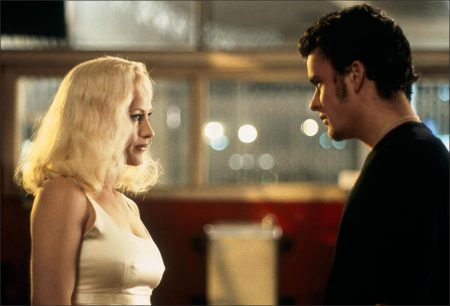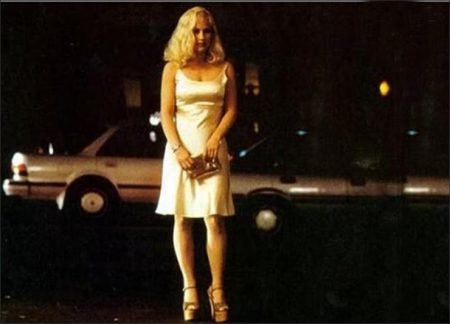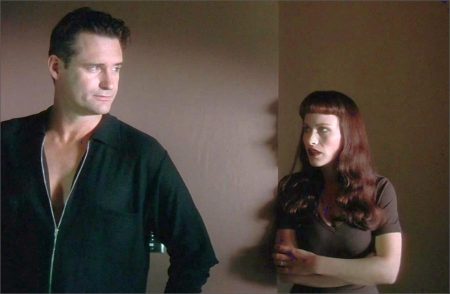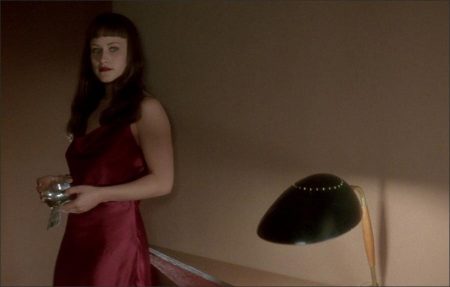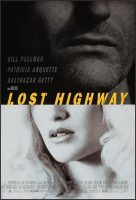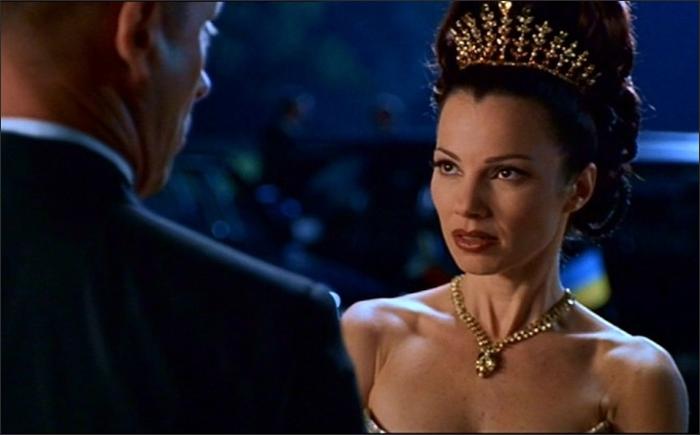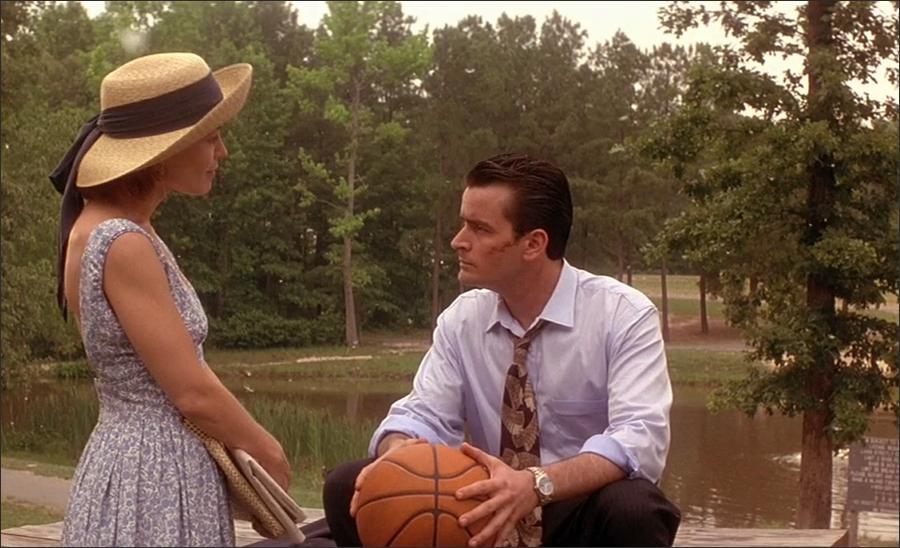Lost Highway movie storyline. Fred Madison, a Los Angeles saxophonist, receives a message on the intercom of his house: “Dick Laurent is dead”. During a break at a show one night, Fred calls his home, but his wife Renée does not answer. Arriving home later, Fred finds her sleeping in their bed. The next morning, Renée finds a VHS tape on their porch which contains a videotape of their house.
After having sex one night, Fred sees Renée’s face as that of a pale old man, then tells Renée of a dream he had about someone resembling her being attacked. As the days pass, more tapes arrive showing the interior of their house and even shots of the pair asleep in bed. Fred and Renée call the police but the detectives offer no assistance.
Fred and Renée then attend a party being thrown by her friend Andy. At the party, the man Fred dreamed about approaches Fred, claiming to have met him before. The man then says he is at Fred’s house at that very moment and even answers the house phone when Fred calls it. Fred learns from Andy that the man is a friend of Dick Laurent’s.
Terrified, Fred leaves the party and heads home with Renée. The next morning, another tape arrives and Fred watches it alone. To his horror, it shows him hovering over Renée’s dismembered body. He is sentenced to death for her murder. While on death row, Fred is plagued by headaches and visions of the Mystery Man, a burning cabin in the desert and a strange man driving down a dark highway.
During a cell check, the prison guard finds that the man in Fred’s cell is now Pete Dayton, a young auto mechanic. Pete is released into the care of his parents, who take him home and allude to–but never fully explain–his disappearance. Pete is followed by two detectives who are trying to find out more about him. The next day, Pete returns to work at the garage where gangster Mr. Eddy asks him to fix his car.
Mr. Eddy takes Pete for a drive, during which Pete witnesses Mr. Eddy chase and beat down a tailgater. The next day, Mr. Eddy returns to the garage with his mistress, Alice Wakefield and his Cadillac for Pete to repair. Later, Alice returns to the garage alone and invites Pete out for dinner. Soon, Pete and Alice begin an affair. Alice fears that Mr. Eddy suspects them, and concocts a scheme to rob her friend Andy and leave town. Alice then reveals to Pete that Mr. Eddy is actually an amateur porn producer named Dick Laurent.
Pete gets a phone call from Mr. Eddy and the Mystery Man, which frightens Pete so much that he decides to go along with Alice’s plan. Pete ambushes Andy and accidentally kills him. Pete notices a photograph showing Alice and Renée together, with Alice claiming that she is the blonde woman in the photo. Later, when police are at the house investigating Andy’s death, Alice is inexplicably missing from the photo.
Lost Highway is a 1997 French-American film written and directed by David Lynch. It stars Bill Pullman as a man convicted of murdering his wife (Patricia Arquette), after which he inexplicably morphs into a young mechanic and begins leading a new life. The movie, which has noir elements, features the last film appearances of Robert Blake, Jack Nance, and Richard Pryor, and the acting debut of Marilyn Manson.
Lynch co-wrote the screenplay with Barry Gifford, whose novel served as the basis for Lynch’s film Wild at Heart (1990). Lynch conceived Lost Highway after the critical and box office failure of Twin Peaks: Fire Walk with Me (1992), a film adaptation and follow-up to the cult television series Twin Peaks. Despite receiving mixed reviews, Lost Highway has developed a cult following and is greatly admired by some critics. In 2003, the film was adapted as an opera.
Lost Highway was shot in approximately 84 days; from November 29, 1995, until February 22, 1996, funded with a moderately large budget of $15 million from the French production company StudioCanal. A vast majority of the film was shot in locations throughout California, in Los Angeles, with the desert scenes being filmed in Nevada. Lynch owns the property used for Fred and Renee’s mansion, and designed it himself, along with most of the furniture. The interior shots of the “Lost Highway Hotel” were filmed at the Amargosa Hotel in Death Valley, which is believed to be haunted.
The first cut of the film ran just over two-and-a-half hours. After a screening with 50 people, Lynch cut out 25 minutes of footage, including a scene portraying Renee/Alice’s autopsy. Lynch would later link the film to the O. J. Simpson murder case: a jealous man’s state of mind who has indeed committed, and then denies, murder, even to himself.
The film’s score was composed by Angelo Badalamenti, with additional music by Barry Adamson. For years, Trent Reznor had tried to contact Lynch to see if he would be interested in directing a video for his band Nine Inch Nails, but had no success. After his work on the Natural Born Killers soundtrack, Reznor received a call asking if he would be interested in doing the same thing for Lost Highway.
Reznor talked to Lynch on the phone and the filmmaker asked if he would also be interested in composing original music for the film. When Reznor agreed, Lynch traveled to New Orleans, where the musician was living, and together they created music that accompanied the scenes in which Fred and Renee watch the mysterious video tapes, a brand new song called “The Perfect Drug,” and “Driver Down,” a song featured at the end of the film. Reznor also produced and assembled the soundtrack album.
Lynch chose two songs by the German band Rammstein; “Heirate Mich” and “Rammstein.” The band based the video for the latter song on this film. The majority of the video is made with clips from Lost Highway. David Bowie’s song “I’m Deranged” was played during the intro and the end credits, in different edit versions, and appears on the soundtrack.
Lost Highway (1997)
Directed by: David Lynch
Starring: Bill Pullman, Patricia Arquette, Balthazar Getty, Robert Blake, Natasha Gregson Wagner, Gary Busey, Robert Loggia, Mink Stole, Leonard Termo
Screenplay by: David Lynch, Barry Gifford
Production Design by: Patricia Norris
Cinematography by: Peter Deming
Film Editing by: Mary Sweeney
Costume Design by: Patricia Norris
Set Decoration by: Leslie Morales
Art Direction by: Russell J. Smith
Music by: Angelo Badalamenti
Distributed by: October Films
Release Date: February 21, 1997
Views: 494
